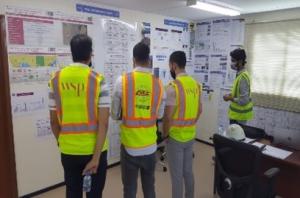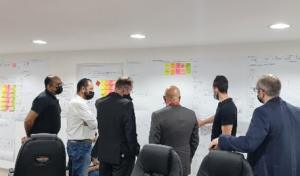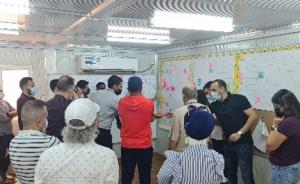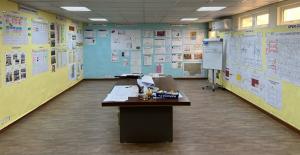Beyond efficiency: How Lean can help revolutionise the construction industry
Construction is a notoriously risk-averse industry that has long been considered to be behind the curve when it comes to adopting new innovations. Being highly fragmented and being subject to a myriad of regulations are among the major factors that reduce the adoption of innovation in this ever-changing industry. In the Middle East, the increasing pressure in recent years to deliver huge and technically complex projects within short time schedules made the industry even more reluctant to adopt new approaches.
Within this context, Lean construction presents an invaluable pathway for practitioners to create a culture that is receptive to new ideas while monitoring the project’s imminent risks, optimizing costs and time, and improving quality. Being a people-centric value-driven approach, Lean can act as a communication sphere for project leadership to induce change and embrace new approaches and technologies. It also provides an organisational framework that incubates and diffuses innovations that deliver value.
When WSP Middle East introduced Lean to one of its large-scale infrastructure programmes in Qatar, considerable resistance was observed with many team members preferring to spend their time on actual construction activities rather than engaging in collaborative planning, work studies and other lean activities. However, after a few months of implementation and with regular training and coaching, such resistance started to fade away especially when significant improvements in overall performance, time-schedule predictability and budget management were highlighted and celebrated.
Higher productivity and better performance are of course highly desired outcomes, but alongside those positive results, higher levels of collaboration, adaptability to change and openness to new ideas were also observed. With the increasing implementation of lean, and as the construction industry continues to evolve, those intangible outcomes of lean implementation are likely to play an increasingly important role in drawing the future of the industry.
Higher productivity and better performance are of course highly desired outcomes, but alongside those positive results, higher levels of collaboration, adaptability to change and openness to new ideas were also observed.
Lean as a bedrock for sustainable innovation
Lean may no longer be considered innovative by some practitioners because its introduction by Toyota dates back to the aftermath of World War II. Some practitioners also believe that with time Lean implementation runs the risk of becoming a routine and inflexible way of operation. However, despite this argument, lean is widely believed to enable one of the most important aspects of innovation; the ability to create new value from existing resources.
Innovation requires a considerable long-term investment in research and development (R&D) and a high degree of collaboration between different firms. In the construction industry, price-based competitions often result in a race to the bottom, where firms undercut each other in order to win contracts. Such competition often means a focus on the short-term goals of achieving profit.
When lean is introduced to a project, it brings team members to collaboratively identify the major inefficiencies of their day-to-day work activities and seek new approaches to address them. One domain where this collaboration has been very useful is sustainability. Lean encourages waste reduction and the efficient use of resources, and this makes it an excellent way to drive sustainable innovation in construction projects.
A real-life example of this was implemented in some of WSP’s projects in Qatar where Lean was used to encourage several construction teams to find new ways to achieve their green objectives. One of the initiatives that were formulated as part of this activity included replacing the traditional diesel-powered on-site lighting with solar tower lights, eliminating carbon emissions and noise from generators and achieving considerable long-term cost savings.
On another project, an average of 25 kg of food used to be wasted daily resulting in 9 tons of waste per year. The waste used to be transported by an authorised contractor to the municipal landfills, an activity that involved a total travel distance of 7700 km a year. To address this situation, a composting machine was placed on-site with the resulting compost used in small scale softscape works, reducing carbon emissions by 26.7 tons a year while saving the money that used to be spent on waste food transportation and disposal. Through lean thinking, the project team did not only reduce waste, they worked collaboratively and did something that most other construction projects will not otherwise do.
When lean is introduced to a project, it brings team members to collaboratively identify the major inefficiencies of their day-to-day work activities and seek new approaches to address them.
Opening channels for collaboration and breaking silos
In construction, it is not uncommon for clients and their supply chain to have different objectives. Project planning is often a task undertaken by a few members of a project team who disseminate the plan and relevant processes in a top-down approach to other team members for implementation. This traditional method of planning often lacks sufficient transparency and leads projects to become bogged down in delays, cost overruns, and conflict.
As shown in the previous example, lean creates the right environment for collaboration and brings team members to work towards the same goal: delivering value to the client as efficiently and effectively as possible. This common purpose helps to prevent problems from arising in the first place, and when problems do arise, they are quickly resolved. The Collaborative Target Program (also known as the Last planner system) for instance brings project team members together in a structured way to put a feasible detailed plan. The input for the plan is taken from all project construction disciplines, leading to higher levels of commitment. Collaboration between different supply chain tiers and different disciplines enhances communication and creates mutual understanding of the project sequences and dependencies leading to successful mitigation of potential issues and avoidance of delays.



The direct communication and mutual understanding created through lean also help break silos between different disciplines which is vital for the future of the engineering industry. The concept of the big room or war room is just one instance of how different disciplines can efficiently collaborate. The room often displays up-to-date content on the project’s progress status, current issues, look ahead plans, etc. Holding daily meetings with all project team members and project leadership in this room to discuss focus areas and issues for each discipline does not only result in better communication, it also supports decision-making, leads to more synergy and lays the ground for new cross-functional initiatives.

Building stronger teams through diversity and inclusion
Inclusive teams are more efficient because they tap into the power of diversity. When everyone feels respected and valued, they are more likely to be motivated and engaged. They are also more likely to come up with creative solutions that challenge the status quo. Inclusion enables the engineering and construction industry to draw talents and resources from a larger pool of resources to pick the brightest minds. Embracing inclusion is thus essential for the construction industry if it wants to be placed at the forefront of innovation. Lean can help the industry become more inclusive because it is based on the belief that everyone has intrinsic worth and deserves to be treated with dignity.
This respect for people is essential for building an inclusive team where everyone feels valued, where diversity is welcomed and different perspectives are encouraged. Within the programme where WSP implemented lean in Qatar, a survey was administered to around 70 professionals to assess how lean implementation helped enhance inclusion. It was not surprising that almost 82.6 of the respondents reported that lean helped them become more engaged and helped their voices to be heard.
Lean implementation results in higher productivity and better performance. However, what matters most for the future of the engineering and construction industry is the intangible outcomes of lean. Collaboration, inclusion, adaptability to change and openness to new ideas are essential for the evolution of the industry. With the current regulations, high client expectations and high market volatility, innovation is seen as an uphill battle by many in the construction industry. Lean has the potential to change these perceptions and provide the right conditions for identifying and adopting innovations.
